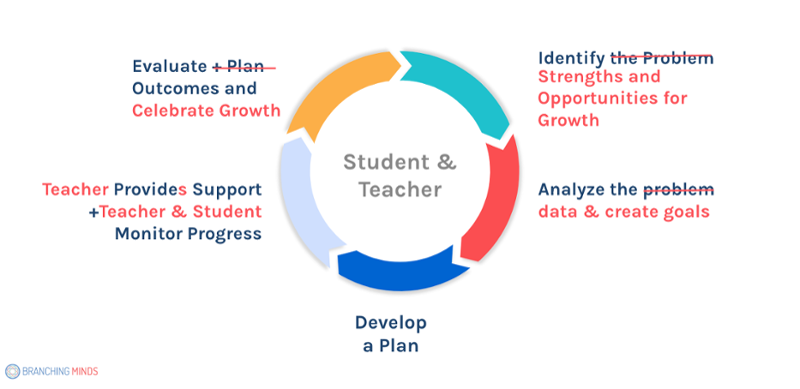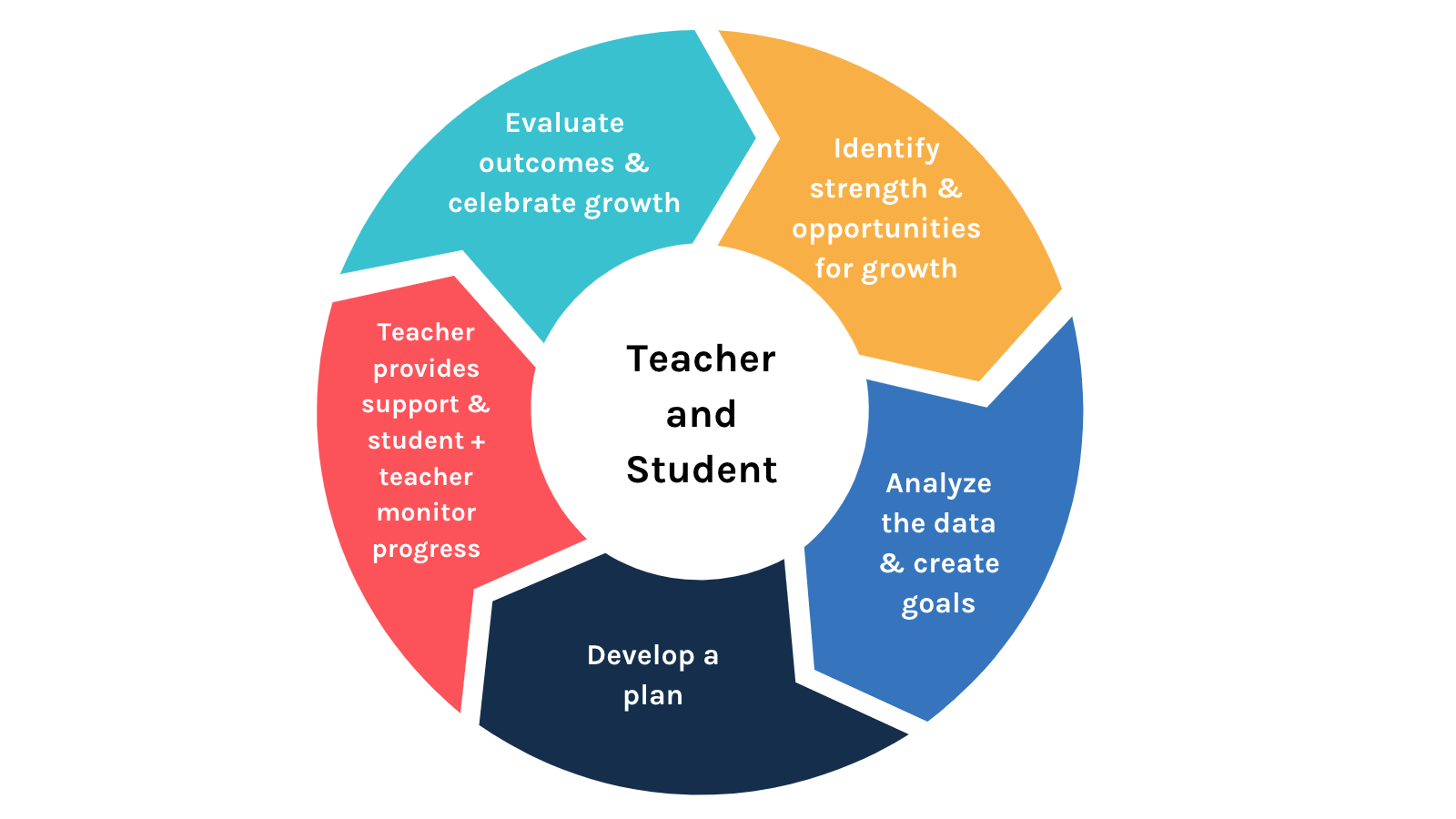Every year I head to my doctor's appointment for my annual check-up. This year, I thought about all the screeners that the doctor used to determine my overall health, as well as the conversation we had in her office as we sat at the table reviewing my results.
Based on my personalized data, we collectively decided areas for improvement and created targeted goals to reach attainable targets. I left the office with a clear plan and was excited to achieve my goals, knowing that the outcome would mean improved health. I was determined and eager to report back to her in three months to discuss my progress.
How can we use this same system to empower our students to own their learning? As educators, we follow this medical model when we gather around the conference room table to discuss student data during grade level and individual student support meetings. We discuss the strengths and needs of students to create support plans, and we match instructional strategies to needs. We formulate plans to track progress, and we reconvene regularly to evaluate and adjust.
Related Resource→ The Power of Strength-Based Instruction
These powerful actions are all regularly undertaken within a school's MTSS (Multi-Tiered System of Support) framework. As a result of our MTSS efforts, we've improved student outcomes and prevented students from “slipping through the cracks.” It's time for all educators to leverage this same course of action and incorporate the voice of our most important stakeholders, our students. After all, educators know it isn't about what is taught but rather what the student learned.
Without student participation at the classroom level, we fail to honor students' ownership of their learning. If students know the targets and can clearly articulate how they plan to reach their goals, they have a higher chance of experiencing success. The Quaglia Institute for Student Aspirations found that when students have a voice, they are:
- three times more likely to experience self-worth in school;
- five times more likely to be engaged in school; and
- five times more likely to have a sense of purpose in school.
What specific actions can we take to create a learning culture in our classrooms where students are at the center of the problem-solving process? Let’s look at the moves we can make to promote student ownership of their learning.
 👇👇👇
👇👇👇

Conference With Students
Before diving into problem-solving mode, it's essential to establish a regular protocol for individual student conferences. Kallick and Zmuda, authors of Students at the Center, stress the importance of using a protocol to promote an open and flexible tone to the conference.
The protocol should include time for students to share self-perceptions about their strengths and needs and educator validation of shared perceptions. This critical information will help guide coaching conversations when goal setting. Questions like, "What do you consider to be your strengths?" "What are some areas in which you may need improvement?" help frame this initial conversation.
Share Data With Students
Now that you have established an effective line of communication with the student, it’s time to name the problem, or in this case, the opportunity for student growth. When students understand the end game, they take on the challenge.
Think about this in terms of a video game. Students know the end game, internal motivation kicks into high gear, and they work tirelessly to level up. For the initial meeting, share universal screening and/or benchmarking data and any other relevant assessments. Remember to look through a strengths-based lens when sharing data, as this data is meant to be seen as a starting point for growth.
Learn more about→ Data-Based Decision Making in RTI & MTSS
Collaboratively Set Goals and Create Plans With Students
After establishing the baseline for student growth, it's time to set goals. Start by co-creating a student-friendly learning target that uses words, pictures, actions, or some combination of the three that identifies what students should learn or accomplish (Learning Targets, 2012).
In addition to learning targets, it is also important to share specific progress monitoring goals with students to track their progress. Once you've collectively set goals, create a plan that includes specific agreed-upon attainable educator and student intentions to support student success. In other words, students outline what actions they will take to work toward their goals, while educators outline how they will support the students in goal attainment. Document your work in the form of a student goal tracking sheet, and include timelines for achievement.
For an additional resource to create these targeted goals, you can read 5 Mistakes to Avoid When Constructing Your Student's SMART Goals. You can also find various goal-setting sheets online, or feel free to create your own.
Schedule Frequent Check-Ins to Track Progress With Students
When students accept the challenge of taking ownership of their learning, they are more interested in monitoring their progress toward success (Student Learning Communities, 2021). To that end, weekly or bi-weekly check-ins can provide dedicated time for students to reflect on their progress, and using student goal tracking sheets is an effective way to anchor this conversation.
A critical component of this check-in includes the opportunity to provide students with feedback on progress and offer improvement-oriented strategies (feedforward) for students. Remember to celebrate small successes during these check-ins to maintain momentum toward goal achievement and validate the power of a growth mindset.
Related resource→ How to use progress monitoring data to guide decision making in an MTSS practice
Continue to meet with students to assess progress and create new targets as goals are achieved. When students know where they are, where they are going, and have a plan to succeed, they develop the skills to reflect on their learning, increasing their drive to learn more. The root of it all lies in encouraging students in a meaningful and relevant way.
If you’re ready to elevate student agency in your classroom, try incorporating these teaching moves after a universal screening window. Be intentional as goal setting is a learning experience in and of itself. When ready, expand this practice as students become comfortable and begin to see their results. Tweet us @BranchingMinds to share your experiences!
WEBINAR: Recharging Core Instruction and MTSS
Thursday, October 7th at 1 PM ET/10 AM PT
Interested in Learning About Branching Minds?Branching Minds is an MTSS/RTI system-level education platform that brings together innovative, easy-to-use technology with the latest insights from the learning sciences to help drive student and school success while making teachers and administrators work easier and more effectively. Branching Minds connects data, systems, interventions, and stakeholders so that educators, administrators, and families can work better together to support students' holistic needs.
|
Content adapted from:
Cook-Sather, A. (2020). Student voice across contexts: Fostering student agency in today’s schools. Theory Into Practice, 59(2), 182–191. https://doi.org/10.1080/00405841.2019.1705091
Corwin. (2016). School Voice Report. QISVA. Retrieved September 13, 2021, from https://quagliainstitute.org/.
Dueck, M. (2021). Giving students a say: Smarter assessment practices to empower and engage. ASCD.
Fisher, D., Frey, N., & Almarode, J. (2021). Student learning communities: A springboard for academic and social-emotional development. ASCD.
Kallick, B., & Zmuda, A. (2017). Students at the center: Personalized learning with habits of mind. ASCD.
Moss, C. M., & Brookhart, S. M. (2016). Learning targets: Helping students aim for understanding in today's lesson. Hawker Brownlow Education.
Nordengren, C. (2019). Goal-setting practices that support a learning culture. Phi Delta Kappan, 101(1), 18–23. https://doi.org/10.1177/0031721719871558

About the author
Michele James
Michele James is an educational consultant for Branching Minds. She has worked in the field of education for over 25 years as a teacher, instructional coach, principal, and curriculum supervisor. Michele earned her BS in Finance from Lehigh University, her M Ed. from East Stroudsburg University, and her principal certification from Edinboro University of PA. She most enjoys coaching students and adults in strategies and practices that help them achieve their goals. Mrs. James writes on a variety of education topics from her hometown in the Philadelphia area.

Your MTSS Transformation Starts Here
Enhance your MTSS process. Book a Branching Minds demo today.


















.png?width=716&height=522&name=Tech-Learning-Most-Influential-Edtech-Product-2025(preview).png)
.png?width=716&height=522&name=MTSS-interventions-secondary-school(preview).png)
